🎹 Roland HP702, HP704, LX705, LX706, LX708, GP607, GP609 | Digital Pianos – UPDATED REVIEW & COMPARISON – June 1, 2023 | PAGE 1
The Roland company has been well known for decades in producing innovative and exciting pro and home music products. From digital stage keyboards to home digital pianos, from digital guitar & drum products to pro audio systems, and from computer midi gear to wireless music technology, the Roland Corp does it all. I have played a variety of Roland keyboard instruments for many years and have enjoyed them very much. They tend to very very reliable product and are well designed overall. This
current line of home

digital piano furniture cabinet models for 2023 include models that came out over the last couple of years including the Roland GP607 and GP609 digital baby grands, but the rest of them came out a couple years ago including all the HP and LX models.
I am reviewing all of these 7 models together (including the baby grand models) in one detailed review because it’s easier to understand the differences among them by comparing each one in that way. So as we go up and down the line you will see what those differences are to better select which model may be right for you, assuming you like any or all of these Roland digital pianos.
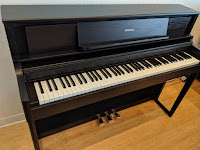
price and in polished ebony it is $5599, and the LX708 is priced at $6399 in a matte finish and $7199 in a high gloss polished ebony, along with the polished white cabinet at $7399. All models come with a matching bench at those prices.
UPDATE! JULY 1, 2023 – There is an unadvertised distributor warehouse instant rebate we just found out about on a popular digital grand piano. While they last you can get an instant additional $2000 off! I have been told there are very few of them remaining in their warehouse so you need to act quickly if you want one.
I’ll start out with a brief comparison summary of the major differences in these models to simplify things a bit. The least expensive model is the HP702 which replaces the previous HP601 and is an interesting piano for Roland because it has the “Standard” piano style key action from the lower priced Roland RP701 piano ($1749 internet discount price) combined with the newer Physical Modeling piano sound technology of the HP pianos. It has the same internal speaker system of the previous model but the cabinet is improved and more stylish looking with more cabinet color options which is a good thing. The next model HP704 has and upgraded

cabinet with more color options and the internal sound system is much better than the previous model and much better than the HP702 along with Roland’s improved upgraded key action called PHA50 (which was in the previous model HP603) combined with the same Physical Modeling piano sound chip also found in the HP702…hopefully this is not confusing you…yet:).
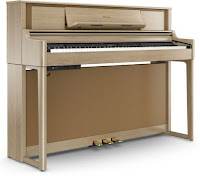
LX705 is identical to the lower priced HP704 and has actually been reduced in power from the previous model HP605. I am not sure why Roland did that but they must have had a good reason.
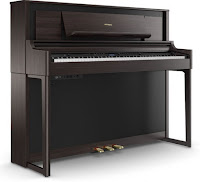
including an additional feature which Roland calls “Pure Acoustic Ambience.”
Medieval Salon, Recording Studio, Trad Opera House, and East Coast Hall. Each physical modeled preset environment is suppose to give the piano sound that you select more realism and can change the overall tone and dynamics of the piano sound. In other words, when you play around with the “Acoustic Ambience” effects and the “My Stage” effects, you can create and customize your own piano instead of just using the 4 default piano sounds. However, using both of these features can be challenging for some people. I will talk about these features in more detail later in this review.
The next model up LX706 has an upgraded cabinet and an improved speaker system over the LX705 and over the previous model LX7. But the improvement in sound really lies with this model having 2 more power amps and slightly larger dome tweeter speakers than the previous model HP605 along with two 10″ bass speakers added in as opposed to the LX705 having no bass speakers. So the quality of sound is going to be noticeably bigger and fuller in the LX706 as compared to the LX705 because of those 2 big 10″ bass speakers and different power amps. The LX706 has all of the new upgraded piano sound features of the LX705, but in

addition to that, the LX706 has a new improved key action called “Hybrid Grand Keyboard.”

LX706 and LX708 to be able to handle these longer keys which allows those keys to move in a different way than the key action in the other models.
In top name acoustic grand pianos, there is a also a standard “key weight measurement” used by qualified piano technicians to adjust and or set the force needed by the keys to play and move up & down properly. Grand pianos generally have noticeably lighter key actions than most acoustic upright or digital pianos based on our years of experience playing them and those acoustic grand pianos measure approximately 55 grams of down-
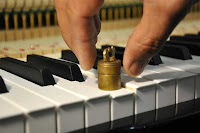
weight/static touch-weight force (the amount of finger force needed to start a key moving downward) measured on middle C, although it could be a few grams less or more than that.

which is about 27 grams (give or take) of weight and that is something which is fairly standard on good grand pianos. The Roland LX706 Hybrid Grand Keyboard measures at about 59 grams of static down-weight (based on my measurements) which is really good for a digital piano and close to a real grand piano.
All models have the imitation ivory-feel and ebony-feel keytops to give a smooth ivory and ebony like finish to the black & white keys which not only looks good, it can also help with absorbing sweat/perspiration from the fingers. I like this proprietary material on the keys and it definitely feels good to the fingers. All key actions in these models have the “escapement” function which tries to simulate the “escapement/let-off” feel that you would get if you were playing a real grand piano and playing the keys very lightly and slowly when feeling a slight hesitation about 1/2 to 3/4 downward in key travel. This can be a useful function and can give you a sense of what key movement can do in

a grand piano in terms of this function…but it’s not absolutely necessary because it’s only
an imitation and definitely not like the real thing.
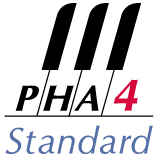
the key movement is actually pretty good overall although playing towards the backs of the keys requires more force because the keys are shorter in length.
The key action in the next 2 vertical upright models HP704 and LX705 along with the 2 grand piano models called GP607 and GP609 have the better upgraded key action called the PHA50 (still with 3 key sensors per key and the simulated “ivory/ebony” key tops) which I briefly mentioned earlier and it’s built differently and moves differently than the Standard key action. The PHA50 has

added thin wood slats that are adhered to the sides of the white keys so not only does the key look more authentic when they are pushed down (you can see the “wood” material on the sides of the keys when you press a key down), but the extra wood material is supposed to give each key a bit more durability and an acoustic nature to the key itself.
The PHA50 also has a “stabilizer pin” in the key to keep it aligned so you have less lateral movement and more stability. I do like the PHA50 key action and how it moves although it certainly does not feel like a grand piano but more like an acoustic upright piano because it takes more finger force to press down the keys, especially towards the backs of the keys when you are playing flats and sharps and your fingers are pressed more closely to the backs of the keys. That’s the way it feels on a real upright/vertical acoustic piano. The overall static down-weight on the PHA50 key action in the HP704 and LX705 is approx 62 grams and up-weight force is about 49 grams.
The LX706 and LX708 have the newer Roland ” Hybrid Grand” keyboard key action (still with 3 key sensors per key and the simulated “ivory/ebony” key tops) but with longer keys in it as I mentioned earlier. The construction of that action is essentially the same as the PHA50 but each key is longer (the part you don’t see located behind the control panel where the visual key ends) so therefore the parts and chassis is extended and modified to fit the

longer keys. As I also mentioned earlier, this new key action is noticeably more realistic than the shorter key PHA50 action, but it is still not like a real grand piano…but it’s getting closer.

improvement over any other key action Roland currently makes for any Roland digital piano or keyboard product in their lineup, and I like it very much. The Roland “Hybrid Grand” key-action has better balance regardless of where you strike the key and more life-like movement as compared to PHA50.action as I mentioned earlier. So when it comes to the Roland key-actions, it’s the one in the LX706
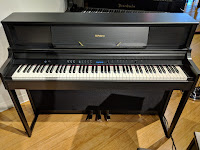
and LX708 that really shines and mainly because of that extra nearly 1 1/2″ in extra length over the PHA50 key action.
Another unique feature worth mentioning which is part of the key action response in the LX708 and the new GP9 digital grand, is called “Haptic key vibrations.” This feature electronically creates a physical vibration sensation within each physical key of the piano to give the player a sense of “organic vibrations” that you may otherwise feel in a real acoustic piano when playing it. If don’t have experience playing a real good quality acoustic upright or grand piano then you would likely not be aware that you can feel a sensation of subtle vibrations coming through the piano keys when playing the piano at a louder volume on an acoustic piano. The

majority of digital pianos cannot do this so when comparing many digital pianos to each other you may not care whether that “key vibrating feature” exists or not because you won’t miss what you don’t know about.
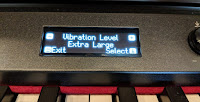
rather than naturally resonating through a wood acoustic cabinet (the Roland pianos and other brands of digital pianos are not made of solid core wood like real pianos are), then the “electronically produced” Haptic vibrations would add a sense of natural realism within the keys when you are playing them and those vibrations can be adjusted to be more or less noticeable if you choose to use them. I will say from personal experience that it is true that you can feel subtle natural vibrations coming into your fingers when you are playing a real acoustic piano and that is something that does not happen in most digital pianos. So with this Haptic vibration feature in the LX708 and GP9, Roland has added a nice touch of physical realism to the piano playing experience that no other Roland piano has and no other brand has in this price range.
The piano sound in the Roland home pianos is unique as compared to other brands in that these Roland pianos use “Physical Modeling” technology. In the previous Roland models called HP603, HP605, LX7, and LX17, Roland used this same technology which means the piano sounds are developed using mathematical algorithms which try to “simulate” a real grand piano sound by analyzing what acoustic pianos actually do in terms of the acoustic piano sound and how it resonates with organic overtones,

vibrations, natural dynamic tones, sympathetic string vibrations, and soundboard vibrations.

real grand piano sound. Roland obviously believes this technology is the way to go and thinks it’s a better way to reproduce the acoustic grand piano sound as opposed to sampling (aka: recording) a real live grand piano using microphones to capture the original sound. Up until now the sampling technology has been the way that all digital pianos have captured the piano sound and then digitized that sound into a circuit board with digital chips and then that sound
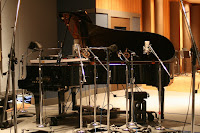
comes out when playing the keys on a digital piano.
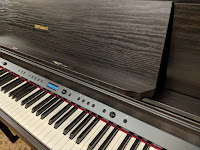
sound technology does not extend to the non-piano instrument sounds of the Roland pianos.
There is also something called “polyphony” which is a feature specification in all digital pianos. The polyphony number is usually described as how many piano notes/keys can be played at one time with out notes “dropping out” abruptly while keys are being played. In other words polyphony really is another word for memory and that memory needs to be sufficient for the piano&

instrument sounds to be able to be played and heard without any of the notes disappearing and dropping out because you have run out of polyphony memory. The top polyphony number these days for “sampled” piano and instrument sounds is 256-notes of polyphony as measured in mono tones. Many instrument and piano sounds are recorded in stereo for the best sound reproduction and a stereo sound takes 2 notes of polyphony memory as opposed to 1 note of
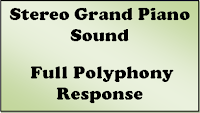
polyphony memory in mono recording.

notes of polyphony or 256 notes of polyphony depending on the model. It’s interesting to note that the top 3 new vertical LX705, 706, and 708 have 256 notes of polyphony while the other models including the lowest price HP702 have the 384-note polyphony memory chip.
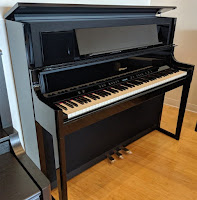 After playing this new line of Roland digital pianos for a number of hours I can say that, in my opinion, it is unfortunately a “mixed bag” when it comes to the piano sound and how “real” it is. It is an interesting mixed “bag” because the new model HP702 & HP704 have the same piano sound chip as the previous discontinued HP models HP603 & HP605 as I mentioned earlier as well as the top current Roland digital grand models GP607 and GP609 having that same piano sound chip. In other words if you played the new HP702, HP704, GP607, and GP609, they would all sound exactly the same…even the key actions are the the same with the exception of the new HP701 which has the more basic standard key action. The biggest differences among all those models is really the cabinet designs & sizes and the built-in speaker systems. When you look at the new LX series including the LX705, LX706, and LX708, those three models have a new “upgraded” piano sound chip which the other Roland pianos do not have.
After playing this new line of Roland digital pianos for a number of hours I can say that, in my opinion, it is unfortunately a “mixed bag” when it comes to the piano sound and how “real” it is. It is an interesting mixed “bag” because the new model HP702 & HP704 have the same piano sound chip as the previous discontinued HP models HP603 & HP605 as I mentioned earlier as well as the top current Roland digital grand models GP607 and GP609 having that same piano sound chip. In other words if you played the new HP702, HP704, GP607, and GP609, they would all sound exactly the same…even the key actions are the the same with the exception of the new HP701 which has the more basic standard key action. The biggest differences among all those models is really the cabinet designs & sizes and the built-in speaker systems. When you look at the new LX series including the LX705, LX706, and LX708, those three models have a new “upgraded” piano sound chip which the other Roland pianos do not have.
 When I play a digital piano for the first time, I don’t try to use any “tricks” or change any editing parameters to try and make the piano sound better or different…I just want to see how the piano sounds when you first power it on…just playing it as a piano with the default settings. The manufacturer should put their “best foot forward” and have their best pianos at their optimal best as soon as you turn the piano on and play it…just like it would be on a real grand piano…you play it and what you hear is was you get. However, with the new LX pianos, I did not like those piano sounds and much preferred the other piano sound chip in the lower priced HP pianos and the GP grand pianos. When I played the LX705, LX707, and LX708 piano sounds recently side by side, the best way for me to describe them is “muffled, mid-rangy, saturated (not much noticeable individual hammer attack or clarity…mostly saturated tone bouncing around), artificial with some individual plunky notes,
When I play a digital piano for the first time, I don’t try to use any “tricks” or change any editing parameters to try and make the piano sound better or different…I just want to see how the piano sounds when you first power it on…just playing it as a piano with the default settings. The manufacturer should put their “best foot forward” and have their best pianos at their optimal best as soon as you turn the piano on and play it…just like it would be on a real grand piano…you play it and what you hear is was you get. However, with the new LX pianos, I did not like those piano sounds and much preferred the other piano sound chip in the lower priced HP pianos and the GP grand pianos. When I played the LX705, LX707, and LX708 piano sounds recently side by side, the best way for me to describe them is “muffled, mid-rangy, saturated (not much noticeable individual hammer attack or clarity…mostly saturated tone bouncing around), artificial with some individual plunky notes,
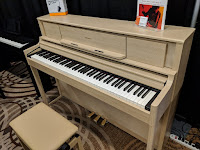
and thinner in the overall tone.”

European #2 and that one was even more artificial in tone sounding somewhat brassy and thin. Finally, the 4th piano sound is called American #2 and that sound was by far, at least to my ears, the most unrealistic and undesirable of the 4 physical modeled piano sounds because it was incredibly twangy and brassy, not usable at all as far as I am concerned.
Another issue with the LX series that I immediately noticed when playing them is that there was, in my opinion, a “stretched tuning” problem which was especially evident to me with the 2 “American” piano sounds which made some note intervals sound noticeably “out of tune” with each other. In other words, there are certain note intervals and the relationship between them (which I use often) especially when playing chords, where the “stretched tuning” process that Roland uses when setting up the original tuning on these pianos is way out of normal stretch tuning range, in my opinion and to my ears. Although stretched tuning method is what good tuners use to set a piano tuning in a real acoustic piano and it varies depending on the size of the piano, it
sounds like Roland “over-stretched” the tuning for the LX series and the result is notes (when played together) grate on your ears…at least they do with me, and I have talked about this issue with other Roland models before such as the low price FP-30X piano (which had no relative tuning adjustments) and other models which use that particular sound chip.

stretch tuning and it sounds natural and within reason and the same was true for the previous HP and LX models which are now discontinued. But with the new LX models, the stretched tuning issue has returned and is very troubling to players like me who play specific intervals often where the “out of tune” issue is most noticeable. I am not saying the entire piano is out of tune because it is not. However, in the “Piano Designer Mode” there is a function called “single note tuning” which allows you to digitally adjust any of the 88 notes slightly up or down in tuning using the piano controls or within the Piano Designer app.
resolve the issue but only if you are good at tuning individual notes and specific notes within specific intervals. If you have a really good “ear” like mine or have piano tuning training, then maybe you
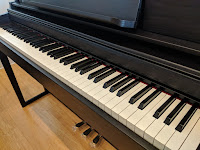
can adjust the tuning between notes in a way that resolves the stretch tuning issue…but for most people I believe this will be a very challenging task. On older Roland piano models like HP506 and HP508 as examples, Roland used to include specific functions for quickly adjusting the “stretch tuning” mode with a couple preset modes and an “off mode” to quickly turn it off which helped a number of people who were sensitive. In the current models of LX series I did not find specific controls designed to quickly deal with the poor stretched tuning that I experienced on these models. If those control features are there then I sure did not see it. Many people may not notice this “out-of-tune” issue at all when playing these Roland pianos but I did but have not noticed these same issues on other current brand of digital pianos from Yamaha, Kawai, Casio, Korg, etc…but just on Roland LX models with this new piano sound chip but not on the HP and GP models.
Just so you know, I am a big fan of Roland music products and have been for many years. I have used them professionally and in my home studio so I like them and have high expectations of them. That’s why when I see and hear stuff that is a negative issue for me, especially on these digital pianos, it disappoints me that Roland did not do a better job given their abilities in the
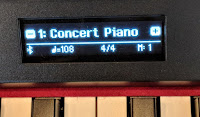
electronic music products world. Unfortunately another continued issue for me with the physical modeling technology in these pianos that was an issue in the previous models is the fact that when you change from one piano sound setting to another, whether they be single piano tones or layered with another instrument sound, when you make that change while playing a song such as going from one movement of the song to another, or from verse to chorus as an example, and you want a new piano sound setting in that part of the
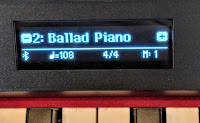
song, when you change from one sound to next when pressing the sound button, the entire note(s) that you have just played and are sustaining will just cut out and stop playing in mid-stream.
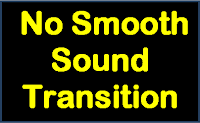
brands also use physical modeling technology although it is different in the other brands. In past models prior to the current Roland physical modeling technology, Roland never had this lack of “smooth transition” from one sound to the next but when they developed this newer physical modeling piano sound technology, that when this issue first began and is still there even in these latest models.

performance at an event or at home, church, school, and you want to change those sounds at different times in different parts of your song. You just cannot do it smoothly without this “all notes off” situation occurring. If this issue was simply a common “glitch,” then it likely could be resolved, repaired, or updated with new software. But Roland has yet to make any changes to the way the piano sounds transition from one to the next so it’s my guess they cannot do it because of the limitations of their technology…and that’s too bad…at least for piano players like me who don’t just want to use 1 sound setting for the entire song the entire time. I personally like to make piano sound setting changes during the song sometimes and have that change be seamless with a smooth transition. But unfortunately on these Roland pianos, this type of thing cannot be done and again, this limitation on all of the Roland models would be a deal-breaker for me, but I am quite picky in that way in being able to transition to different instrument sound settings while playing a song.
-Please click on this link to continue with this Roland Piano Review on Page 2
If you want more info on new digital pianos and LOWER PRICES than internet discounts, please email me at tim@azpianowholesale.com or call direct at 602-571-1864.






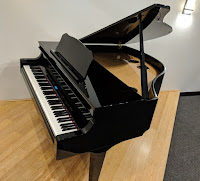

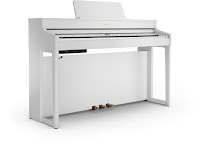


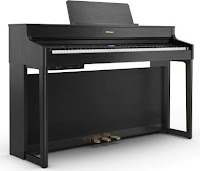

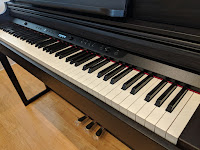

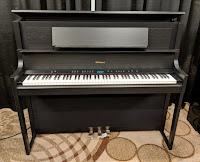
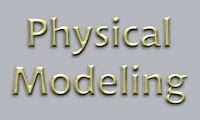

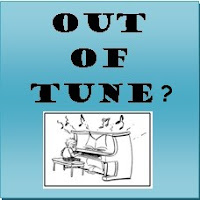

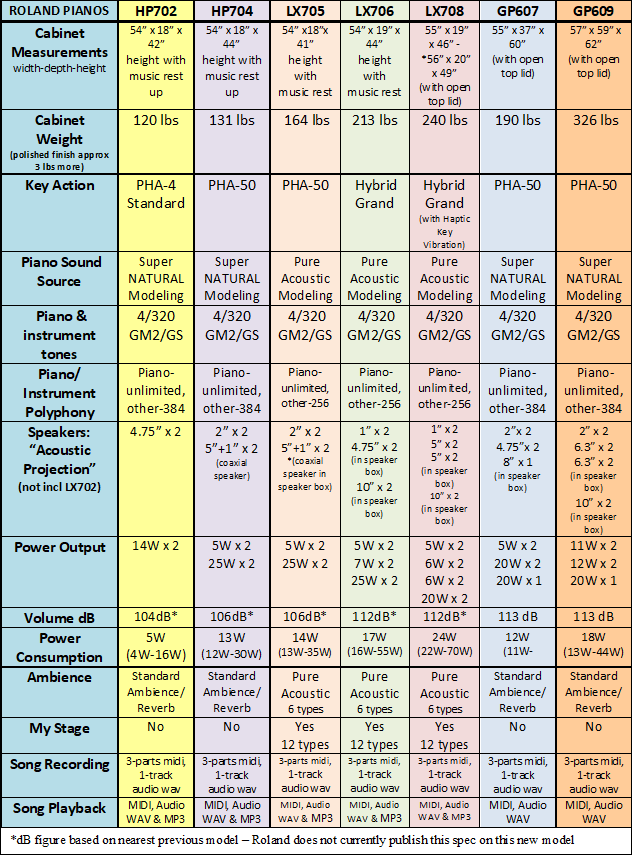











I agree this review; I am only an amateur. I have been using, at home, a GP607 since 2018 and I am enjoying it a lot; I like it very much. My wife is a piano teacher so we have also an acustic upright. Few months ago I played, in a shop, a new model LX708, a great look indeed, and I was a bit disappointed by the artificial sound; I thought to be wrong. I still prefer my older mini GP piano (I think quite good the default "concert piano" not the other piano sounds, very poor and I never use them). The LX708 default-sound looks more similar to the "other piano sounds" in my GP607. I didn't feel a so large difference beetween the keyboards too.
Hi. You don't seem impressed with the Roland LX705 preset piano sounds – neither am I. Do you have any recommendations for the best settings. There are that many variables I can change that I'm confused. Any advice you can offer will be appreciated
Great depth. Enjoyable read. Thank you.
Thanks for the review, as always. I have a question for clarification. When you talk about key length, are you measuring front to back of key, or are you really talking about the pivot distance, front of key to pivot point? Because those aren't the same thing, especially on the Roland vs. Kawai. The Roland pivot point looks to be very near the back fo the key (the hinge, basically), but the Kawai pivot is under the front balance pin (only about 2/3 of the distance to the back of the key). Those would be the measurements I'd be more interested in. Thanks!
Great review thanks.